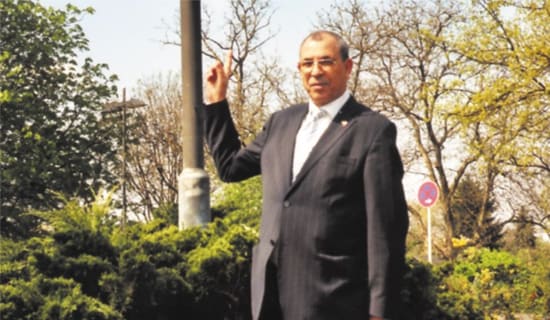Rabin's June 1994 clarification to Assad that "full withdrawal" referred to the June 4, 1967 borderline paved the way to negotiations over the security arrangements between Syria and Israel.
Rabin, Seale claims, demanded security arrangements that would limit Syria's military capability and guarantee Israel long-term military superiority. Assad, on the other hand, "does not want peace that will strengthen Israeli regional superiority by allowing it additional strategic advantages. He thinks Israel still conceals ambitions for hegemony and tries to realize them under the cover of the peace process." At the same time, Assad views the peace process, primarily, "as a diplomatic means to regain the land Syria lost to Israel in the 1967 war."[1]
Therefore, Assad tried to limit the security arrangements so that they would answer only what he viewed as "real" Israeli security needs. He demanded that security arrangements be "equal [mutasawiya], mutual [mutakafi'a], and reciprocal [mutakabila]," and stressed that peace itself was the best guarantee for security. [2]
Two main issues were discussed in the negotiations over the security arrangements. The first was Rabin's demand to keep the early-warning ground station on Mt. Hermon after the peace accord. The second was Rabin's demand to limit the military deployment of Syrian forces after the accord.
Assad rejected the first demand because he sees the Hermon station as a symbol of the occupation.[3] He told Christopher that Rabin's commitment to withdraw to the 1967 border did not mean that Israeli demands in the negotiations on security arrangements must not remain reasonable. He further explained that the needs of one state must stop at the borders of the other state, just as the freedom of one person where the freedom of another person begins.[4]
Assad angrily rejected Rabin’s second demand, to limit Syrian military deployment by dividing Syria to 4 zones - one demilitarized, another with restrictions on weaponry, a third zone in which only two Syrian divisions and one military airport would be allowed, and a fourth zone with no restrictions. He said that instead of withdrawing from the Golan, Rabin wants to occupy all of Syria, disarm it, and deprive it of the capability of self defense.
Assad presented, through Christopher, his principal position that the security arrangements must be confined to the contact areas between Israel and Syria, i.e. a narrow strip, 5-7 km, on both sides of the 1967 border. This strip, in which military deployment would be prohibited or restricted, was termed "the relevant areas." This issue also created a dispute between Israel and Syria over the width of the strip.
Reaching a "Non-Paper"
On May 24, 1994, there was progress, when both sides agreed on a one- page document, a "Non-Paper," titled "The Goals and Principles of the Security Arrangements." Seale publishes this document and explains the long dispute over article 4, which dealt with the border. The "Non-Paper" read: "The security arrangements should be confined to the relevant areas on both sides of the border between the two states."
Israel appeared to accept Assad's position that the restrictions on military deployment should be limited to a strip of "relevant areas." On the border issue Israel's vague formula, "on both sides of the border" was preferred to the specifically defined Syrian formula "on both sides of the June 4, 1967 border." Seale explains that despite accepting this vague version, Syria did not give up on the 1967 border. Rather, the Syrians acceded to Christopher's request to avoid the disclosure of Rabin's secret commitment at that stage.[5]
To assure Assad that his acceptance of the vague formula in article 4 of the "Non-Paper" did not annul Rabin's commitment, the Americans proposed to deliver a letter to Syria in which they would clarify that "border" means the June 4, 1967 border. However, Rabin adamantly objected to the idea of a letter. Dennis Ross told Assad that Rabin objected to written clarification not to the verbal one, namely, to the format rather than the substance.
At this point, Ross offered a new formula according to which Israel committed to the US not to Syria and therefore, the commitment became "a deposit in the pocket of the US." Ultimately, Assad agreed that a written letter would not add to the verbal guarantees given by Clinton, Christopher, and Ross. Nevertheless, Clinton ended up sending Assad such a letter, despite Rabin's objection.
The Meeting of the Chiefs-of-Staff and Clinton's Letter to Assad
In June 1995, Clinton urged Assad to send his Chief-of-Staff, General Hikmat Shihabi to Washington to meet with his Israeli counterpart, Amnon Shahak, and conclude the security negotiations. But a problem emerged: Sahak did not know of Rabin's "deposit." Therefore, Clinton demanded that Shihabi not mention the "deposit" when he met with the Israeli Chief-of-Staff. Ross explained to Assad that if Shahak knew of the "deposit," he might have to reveal it in his testimony to the Knesset.
On June 6, 1995, Clinton delivered, through Dennis Ross [despite Rabin's objection], a letter that read: "As I told you in Damascus and as I told your Foreign Minister, I have in my pocket a commitment by Prime Minister Rabin to a withdrawal to the June 4, 1967 border." Clinton added, "It is not appropriate to publicly mention it," when the Chiefs-of-Staff meet.[6]
Seale writes that Assad was ready to go on with this "farce" only to protect Rabin from his political adversaries. But, he was clear to Christopher and Ross that Syria had no alternative but the June 4, 1967 border. [7]
Negotiations after Rabin’s Murder
According to Seale, Shimon Peres, Rabin's Foreign Minister and the new Prime Minister, was surprised when Clinton mentioned "Rabin's Deposit" at his funeral. On December 4, 1995, Dennis Ross went to Jerusalem to brief Peres on the negotiation's details. Peres invited Chief-of-Staff Shahak, and General Dani Yatom to this meeting.[8]
On December 11, following his meeting in Washington with Peres, President Clinton called Assad and said he had "good news:" the new Israeli Prime Minister had adopted Rabin's commitment and expressed hope for a meeting with the Syrian President soon.
However, while Rabin focused on Israeli security arrangements, Peres concentrated on regional economic development and securing Israel's water resources. He demanded Syrian guarantees that Golan water flowing to the Sea of Galilee would be secured and he wanted to build Syrian-Israeli joint projects in the Golan.[9]
Assad responded to Christopher that he had never considered stopping the flow of water to the Sea of Galilee or polluting this water, pointing out that "in any case, Syria has a share of the lake." Assad rejected the idea of joint projects in the Golan, claiming Syrian public opinion would see such projects as perpetuating the occupation by other means and a symbol of Israeli hegemony. He was not enthusiastic to meet with Peres, because Assad wanted to hold this chip until he saw real progress. [10]
When Ross informed Assad that the new Israeli Prime Minister, Netanyahu, rejected the "deposit," he invented a new phrase that "nothing is agreed until everything is agreed."[11] Now Barak uses the same phrase in his refusal to accept Rabin's commitment.
However, Seale explains, this "verbal trick" derives from Israel confusing the term "commitment" with the term "agreement." Assad understood that Rabin's commitment was conditioned on reaching an agreement on the other elements of the peace deal. He is also aware that such an agreement was not accomplished. Nevertheless, from Assad's perspective, Rabin's commitment is still valid. Without it, Seale concludes, Assad would not have entered the peace process to begin with.[12]
Epilogue
The disclosure of secret correspondence between the American and Syrian Presidents through Patrick Seale is unusual. It aims to prove that the American statements about there being no agreement contradicts clear American guaranties that were given to President Assad both verbally and in writing. Seale concludes his articles quoting former American President George Bush's letter to President Assad, on the eve of the Madrid Conference in 1991, which included an American commitment to the "implementation of the principle of 'land for peace' on all fronts, including the Golan heights."[13] This reference seems to be aimed at Governor George W. Bush Jr., who is running for the presidency, after the Syrian leadership has been, apparently, discouraged by Clinton and his Administration.
The Syrian Spin on the 1993-1996 Negotiations Part I
[1] Al-Hayat (London), June 22, 1999.
[2] Al-Hayat (London), June 22, 1999.
[3] Al-Hayat (London), June 22, 1999.
[4] Al-Hayat (London), June 22, 1999.
[5] Al-Hayat (London) November 22, 1999. Christopher, however, stated in a letter to Israeli Prime Minister Netanyahu: "I did not see the 'Non-Paper' [delivered by Rabin] as legally binding." Itamar Rabinovich, On the Threshold of Peace, Israel and Syria 1992-1996, Yediot Ahronot Publishers, pp. 24-5. In interview to Ha'aretz (Israel) October 24, 1997, Christopher said: "Nothing is agreed until everything is agreed... Everything Israel offered was conditioned." This American position was formulated in negotiations between Netanyahu's political advisor, Dore Gold, and Christopher. See Ze'ev Schif, Ha'aretz (Israel), October 19, 1999.
[6] Al-Hayat (London), November 22, 1999. Seale does not clarify why Clinton sent such a letter after Assad had agreed to verbal guarantee. He seems to imply that the letter was meant to facilitate Assad's agreement to the meeting between the Chiefs-of-Staff in Washington.
[7] Al-Hayat (London), November 22, 1999.
[8] Al-Hayat (London), November 23, 1999. Seale writes that Peres hinted in the meeting that if it were him and not Rabin, he would have already reached peace with Syria. This comment was delivered by Ross to Assad, who so this as positive development.
[9] Al-Hayat (London), November 23, 1999.
[10] Al-Hayat (London), November 23, 1999.
[11] As was mentioned, this American position regarding the "deposit" was publicly announced for the first time in early November 1999.
[12]Al-Hayat (London), November 23, 1999.
[13] Al-Hayat (London), November 23, 1999. The letter appears in Bush's new book: George Bush, All the Best, George Bush: My Life in Letters and other Writings, Scribner, pp. 523-4.








